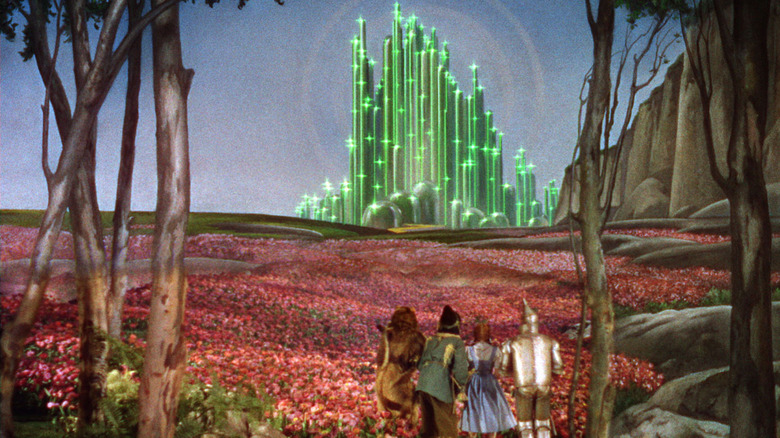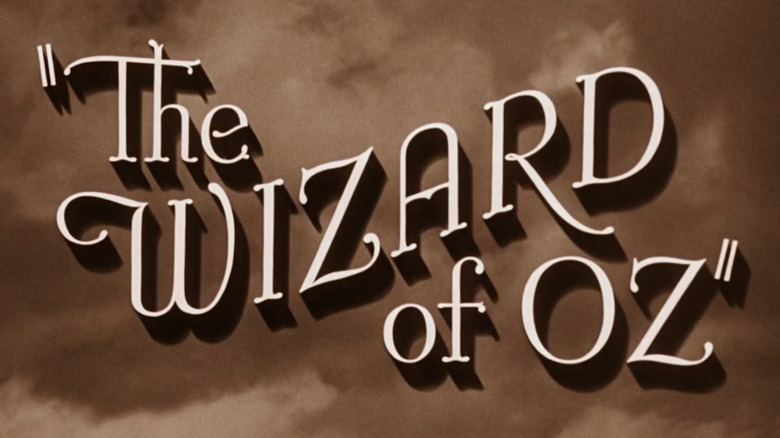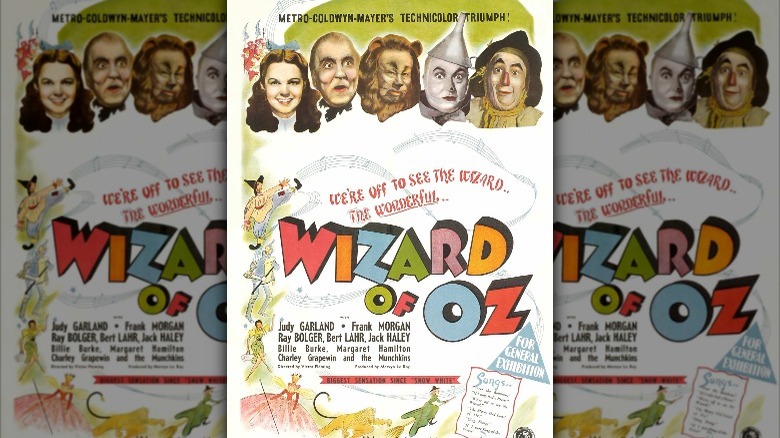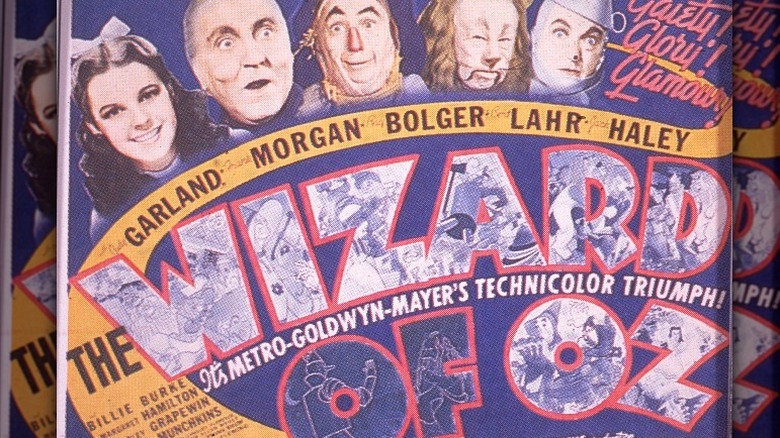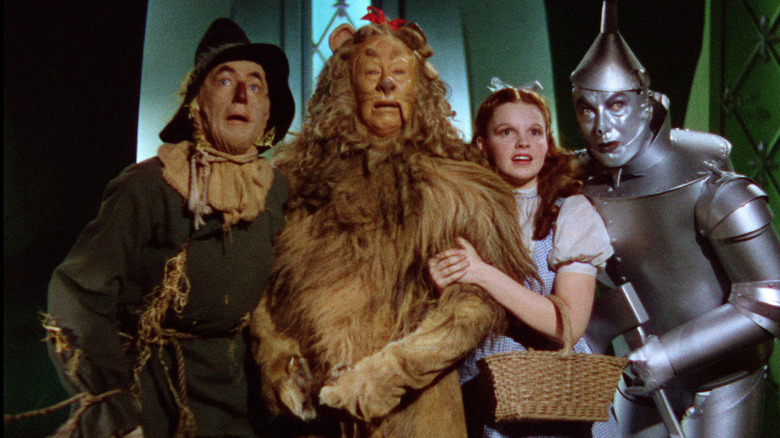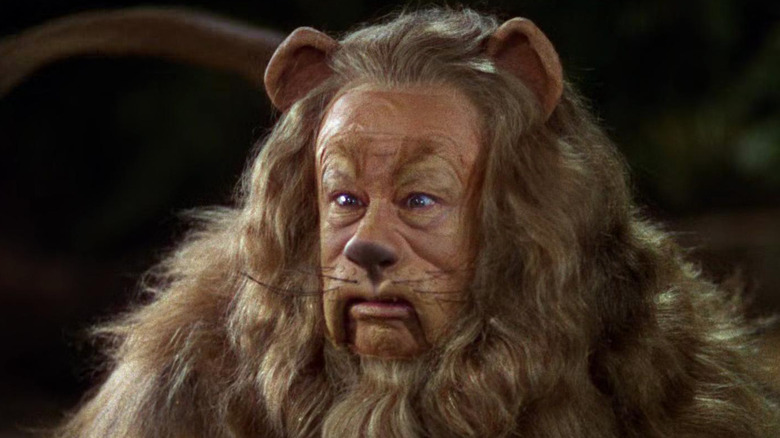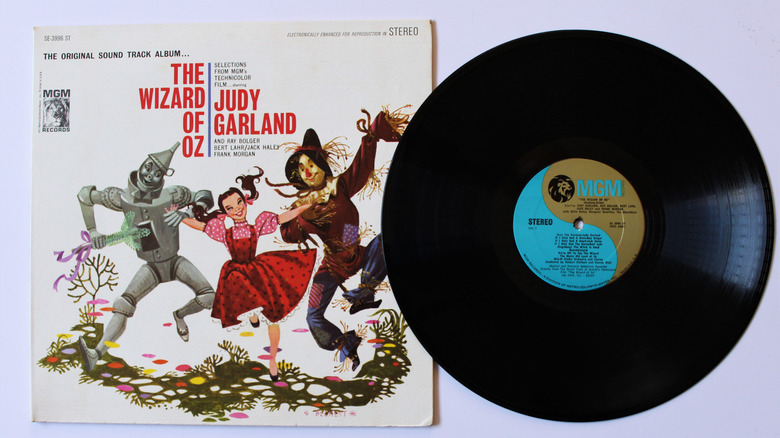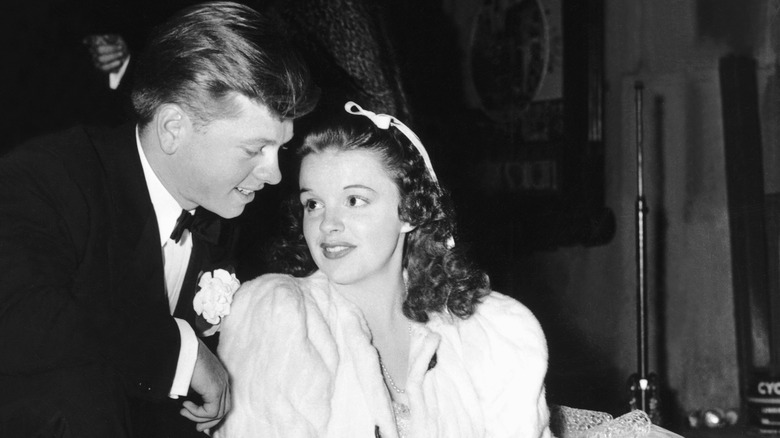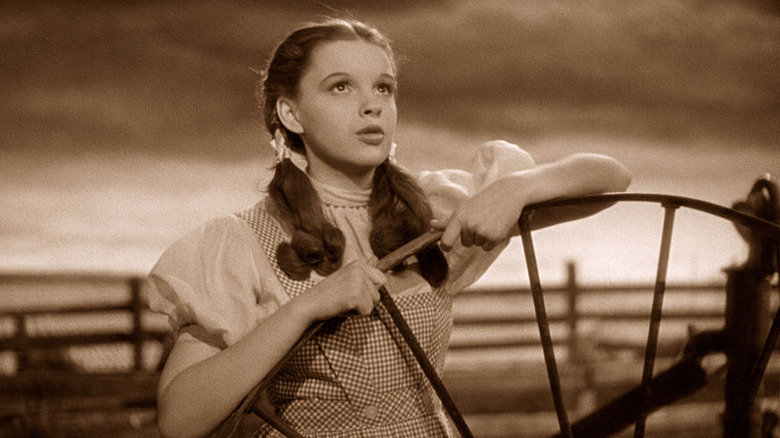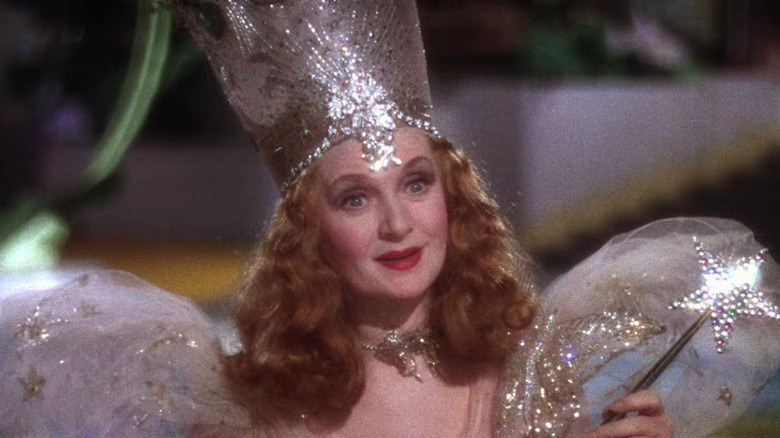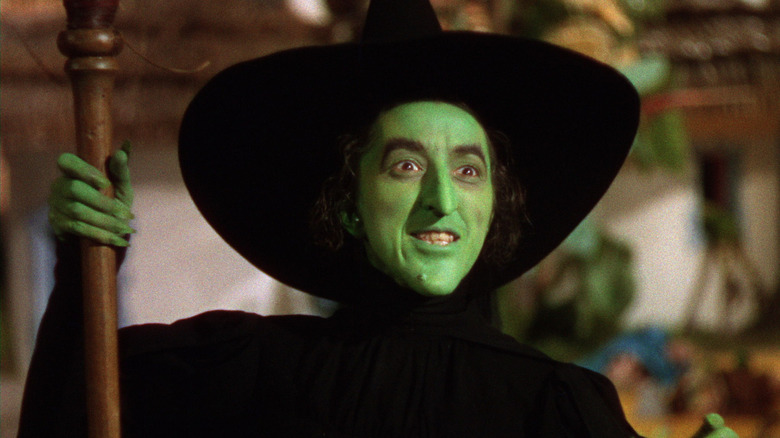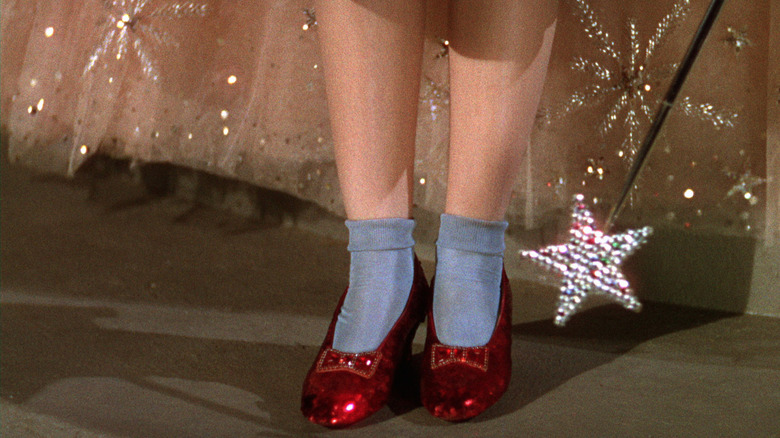What It Was Really Like To See The Wizard Of Oz In 1939
There was no red carpet when "The Wizard of Oz" premiered towards the end of summer in 1939. Even the stars didn't attend, but far from the Hollywood glitterati, it still cast a spell over audiences.
Viewers are swept up in Dorothy Gale's unexpected adventure after she dreamily muses about what it would be like over the rainbow. When her house is suddenly whisked away by a tornado, she ends up in the mythical land of Oz, where scarecrows talk, trees have faces, and there are such things as good witches and bad witches. With her friends the Scarecrow, the Tin Man, and the Cowardly Lion, Dorothy must find her way to the Emerald City and meet the mysterious wizard to grant her wish. She only wants to go back home.
MGM spent $2.8 million—an amount unheard of then—to bring L. Frank Baum's fantasy "The Wonderful Wizard of Oz" to life on the silver screen (via History). This was an immense risk for the studio, which went all out with costumes and scenery and special effects. What started out anxiously tiptoeing in its ruby slippers would turn into a phenomenon. Here's what it was really like to see "The Wizard of Oz" in 1939.
The premiere was in the middle of nowhere, but almost as flashy as Hollywood
Whoever went to the world premiere of "The Wizard of Oz" on the night of August 12, 1939, at the Strand Theatre in Oconomowoc, Wisconsin, knew something was up, though going to the movies was already an event. There was a reason movie theaters were once called "picture palaces." According to The Museum of American Heritage, they really were palatial, from ornate Art Deco facades to the plush seats and carpets under glittering chandeliers. A ticket at the Strand would have still only cost you 25 cents for a matinee (about $5 in 2022) and 40 cents if you made an evening of it, as per WISN 12.
As theatergoer Catherine Buckeridge told Wisconsin news channel WISN 12, when "The Wizard of Oz" opened at The Strand, everyone was dressed as if they had been invited to a Hollywood gala, and people were eagerly buzzing around the door. She was then a wonderstruck teenager dazzled by the lights and commotion. The film completely sold out each of the five nights it played at the Strand (via WPR), and its popularity spread almost like magic when it was officially released on August 25.
It should be noted there are conflicting reports of when the movie premiered, as several cities have claimed bragging rights to film's soft opening.
Fantastical marketing would have gotten you hyped
Just the movie posters, inspired by circus ads, were enough to generate excitement for the film, proclaiming things like "It took two years just to plan it!" and "Startling balloon ascent!" Even details about the costumes and special effects were blasted on these posters just to emphasize how unbelievable they were. There is one poster in Syracuse University's archive that roars about Burt Lahr wearing a costume made from 50 pounds of real lion skins for his role as the Cowardly Lion, and another that shows off the fantastical sights as if Oz were an actual tourist attraction. Who wouldn't want to see flying monkeys?
Entire articles were written in magazines and newspapers as advertisements. MGM spent a massive amount to buy ad space in every publication it possibly could and print full-color Kodachrome cover art. Merch appeared in some unusual places. In her "History of T-Shirts," branding expert Alyssa Mertes at Quality Logo Products notes that the first promotional T-shirt ever was featured in the movie. You can see the green tee, made by Hanes and emblazoned with "OZ" in bold white, worn by the three Emerald City beauticians giving the scarecrow a makeover by re-stuffing him. According to the South Florida Reporter, no other film had been advertised that way before.
But you'd have to storm Emerald City to get a ticket
In the weeks following the smash premiere at the Strand Theater, "The Wizard of Oz" opened in theaters nationwide. As the Los Angeles Times notes, most critics were oohing and aahing over the spectacle of the film itself and the individual performances, especially Burt Lahr's antics as the Cowardly Lion and rising star Judy Garland's haunting rendition of "Over the Rainbow." If you managed to get in and see it in a sneak preview in San Bernardino, Aljean Harmetz, author of "The Making of the Wizard of Oz," told The Telegraph you would have seen the entire uncut film, including the "Jitterbug" scene that now only survives as footage from an outtake, since the version that was left on the cutting room floor has yet to be found.
MGM publicists wasted no time once they saw the movie's potential. It obviously worked, because, according to the Oz Museum, many theaters were crowded soon after it officially opened. If moviegoers followed the yellow brick road to some advanced screenings shortly after the premiere in New York, they would have had a chance to meet Garland and other cast members who made appearances.
You would have been over the rainbow for Technicolor
Making movies in color was not really a thing in 1939. "The Wizard of Oz" was one of the first movies (along with "Snow White") to be shot in technicolor. Scenes in the land of Oz were filmed with eight technicolor cameras and used a technicolor machine in theaters, which needed a trained attendant to operate it. Those who saw "The Wizard of Oz" during its first run remember the saturated colors as one of the things that stood out the most, according to the National Museum of American History. As Catherine Buckeridge recalled to WISN 12, the technicolor experience was "very impressive because we had never seen color before."
If you went to the movies often in the 1930s, you would have been used to sepia tones. Now imagine suddenly being dazzled by the realm Dorothy steps into once her house crash-lands in Oz. For the first time, you would see flowers blooming in every shade of the rainbow, the Wicked Witch of the West at her greenest, and those infamous ruby slippers (which you might have expected to be silver if you read the book) dazzling in the sunlight.
Oz was full of familiar faces
Judy Garland was on her way to stardom before the film that forever transformed her, and Burt Lahr, Jack Haley, Ray Bolger, Margaret Hamilton, Billie Burke, and Frank Morgan were already recognizable during that era. There was only one mask used in the movie, for Ray Bolger as the Scarecrow — an original program given out at the Hollywood premiere states that makeup artist Jack Dawn made sure viewers could easily tell who the rest of the actors were under their makeup.
You would have probably recognized Lahr from starring opposite pint-sized starlet Shirley Temple, who was rumored to be originally cast as Dorothy (via History), in 1938's "Just Around the Corner." Despite the obvious amount of makeup and fur that went into transforming him into the Cowardly Lion, you can tell that is still his face under there. Jack Haley, the Tin Man, had also starred alongside Temple in "Poor Little Rich Girl" and "Rebecca of Sunnybrook Farm," both of which preceded "The Wizard of Oz," and also with Garland in "Pigskin Parade" as she rose to fame in 1936. Tween to teen girls who already idolized Temple would have been able to put names to those faces.
The songs would have been playing in your head on repeat
In an era without music streaming, "Over the Rainbow" and "We're Off to See the Wizard" were instant hits. "Over the Rainbow" soon became one of the most demanded songs on the radio. What is now thought of as the greatest soundtrack of all time, according to The Guardian, appealed to listeners from the beginning because of its whimsy. The wistful sadness of "Over the Rainbow" resonated with audiences who could use something to take them far, far away from the hard times of the Depression. "We're Off to See the Wizard" was catchy enough for critics like Variety's John C. Flinn to be skipping along to it.
The songs from the film were so powerful that they were part of the reason the film became a cultural icon. Some, especially "Over the Rainbow," were both a return to innocence and a form of expression in a time of need, as authors from Sheffield University point out. "Ding Dong the Witch is Dead" vented the anger and frustration that had built up after the massive stock market crash, according to Raymond Knapp in "The American Musical and the Performance of Personal Identity," which all but broke the human spirit during the bleak 1930s.
Judy Garland went from girl next door to It Girl
The teenage actress was instantly dubbed "America's Sweetheart" in the afterglow of her star performance as Dorothy, according to Vogue. Legions of little girls wanted to be her embodiment of Dorothy, and many were already Shirley Temple fans who recognized the Tin Man and the Cowardly Lion as famous faces that appeared in Temple's earlier movies and also one of Garland's. There was something about the way Garland played the character who was courageous but still compassionate and vulnerable, as Roger Ebert said in his analysis of "The Wizard of Oz."
Garland became such an icon that every girl's dream was to have something, preferably memorabilia from the movie, autographed by her. Oz Museum recounts the story, which has now become a legend, about a young girl in a Santa Ana hospital who was obsessed with "The Wizard of Oz." In her sleep she would call out to Dorothy. Her heartbroken mother wrote Garland a letter asking if she could send her daughter an autographed photo, but the actress went over and above the rainbow. She visited the hospital (some say in her Dorothy costume) to sign an autograph in person.
It was also relatable for Depression-era audiences
"The Wizard of Oz" was a respite for those weary from the Depression, as Britannica details. The desolation of the era is part of the reason everything that transpired at the Gales' farm was filmed in dreary black and white. "Over the Rainbow," sung by a melancholy Judy Garland to a colorless rainbow, reminded audiences to keep believing, as reviewer Frank Nugent said in The New York Times when the film was first released. Ms. Gulch, the richest woman in the county, and her wicked witch alter ego symbolized the greed, evil, and oppression of the era. And the Wizard? Just a con man "rich in ... innuendo," as The Hollywood Reporter noted after the release, much like President Herbert Hoover, who's relief actions largely failed and has often been criticized, as per History.
From Dorothy's homesickness to laments of the Scarecrow, Tin Man and Lion seeking a brain, a heart, and courage, there were so many elements of the movie that proved there was still humanity in a world that was otherwise imaginary. Dorothy was seen as something of a heroine who still thought there was no place like home.
The reviews were mostly glowing
There were raves for what one film critic writing for the Dallas Morning News called "[the] best movie that Metro-Goldwyn-Mayer has manufactured in many a moon" (via Genealogy Bank). The same unnamed critic mentioned that he personally thought it was up there with Disney's "Snow White," which was supposedly the blockbuster MGM was trying to outdo (via the Los Angeles Times). Critics were also mystified over how the studio managed to pull off things like Dorothy picking an apple from an angry tree that snatches the apple right back. Sure, the evil tree was just an actor in a rubber suit that zipped up in the back, as the Dallas Morning News critic revealed, but the magic was in the suspension of disbelief.
Though Variety critic John C. Flinn noted that some liberties had been taken with L. Frank Baum's novel, he was enchanted. The plot is really just the trek to Oz for a brain, courage, a heart, and a home. Flinn and other critics thought that it was really the performances and effects that took the movie over and above expectations.
But some critics thought it was (gasp) vulgar
When Russell Maloney reviewed the movie for The New Yorker, he actually said, "The vulgarity of which I was conscious is difficult to analyze." Reasons behind the cringe included "eye-straining Technicolor" and special effects — such as the Wicked Witch of the West melting — that he found more aggravating than amusing. The Technicolor, in Maloney's opinion, was overdone to the point that you could hardly watch what was happening onscreen. Then there was his gripe about the Wicked Witch. It really has more to do with the Wizard's reaction to her demise, which was just one of the many "gags" he absolutely did not find amusing. Maloney was even convinced Burt Lahr's Cowardly Lion didn't belong in Oz. He thought there was no imagination to a film that was supposed to capture the imagination.
The Los Angeles Times goes on to note that many critics were put off by the more modern elements used in the film, such as the Wicked Witch of the West using her broom to skywrite "Surrender Dorothy" above the Emerald City.
Critic Otis Ferguson, who reviewed the movie for The New Republic, saw it as a try-hard coming for "Snow White's" success. He could not see the humor. It would be appealing for kids, in his opinion, because they would be caught up in all the flashy special effects and not understand what it was lacking. Some of those effects were (ironically) what he liked most.
It only ended up being kind of a blockbuster
"The Wizard of Oz" sold out in theaters, with half of the audience being eager, wide-eyed children, as William Stillman, co-author of "The Wizardry of Oz," told the Los Angeles Times. The majority of critics were enchanted. It was one of the top films of 1939, beaten only by "Gone With the Wind" for the coveted Best Picture Oscar. However, "The Wizard of Oz" received its own Academy Award wins and nominations.
The thing about movies back then is that they were very short-lived, as film historian Scott Essman also told the Times. Once movie-goers saw them, they were forgotten. A hard fact to fathom with today's technology of streaming services or DVD and Blu-Ray players to keep them frozen in time — and there was no such thing as a classic that endured. That was something even its most adoring fans had no idea it would turn into.
Unfortunately, with a production cost of about $3 million, it only brought in about $3 million despite so many sold-out shows. Movie tickets were pretty cheap back then, so despite its sell-out popularity, the numbers simply wouldn't add up to major profits. Still, if ever oh ever a wiz there was, "The Wizard of Oz" is one because this cinematic treasure is eternal.
